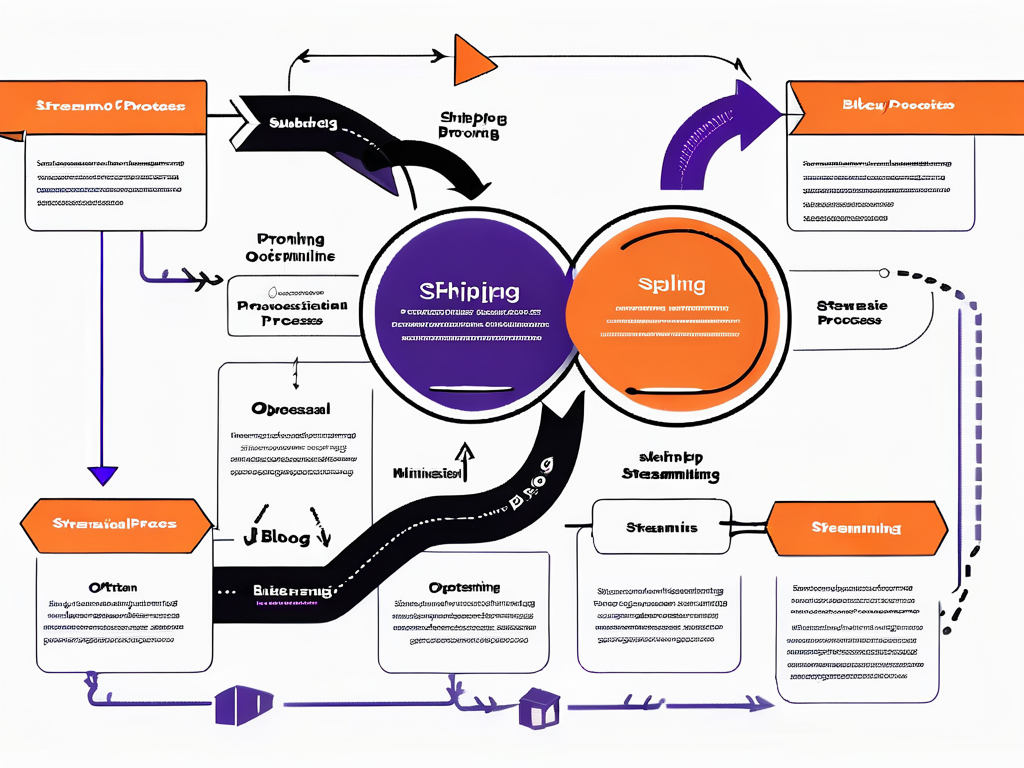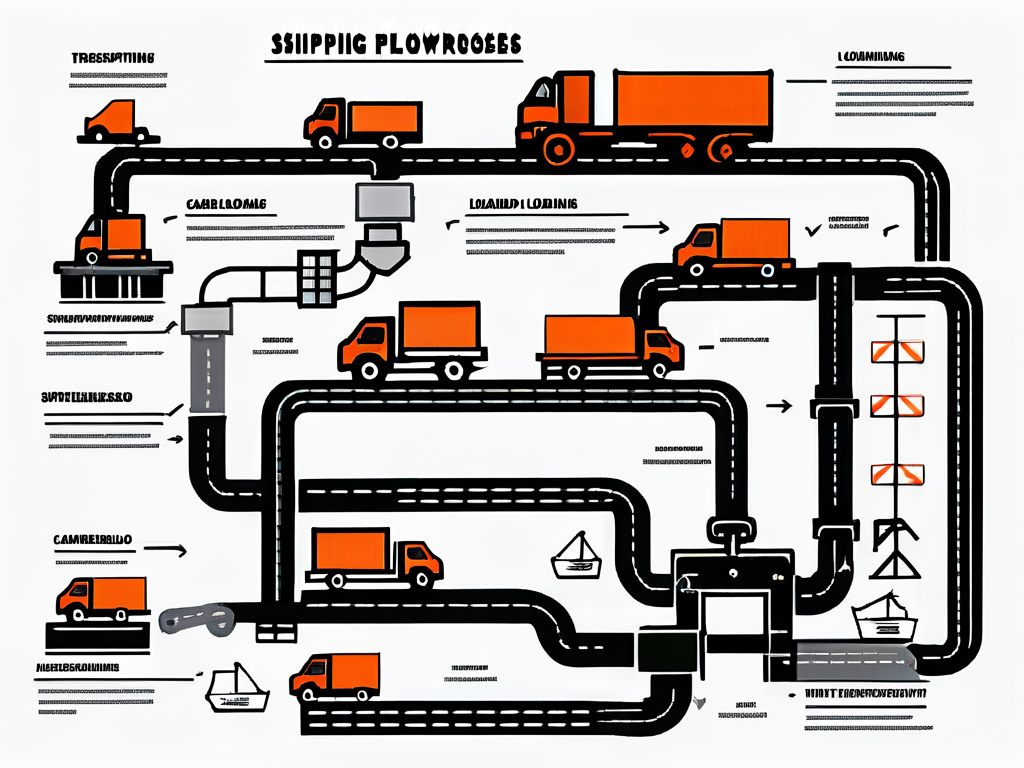In the complex world of logistics, a shipping process workflow is a critical component that ensures the seamless movement of goods from point A to point B. It is the systematic series of steps and activities involved in managing and executing the shipping process, guiding every aspect of the supply chain.
Understanding what is a shipping process workflow in logistics is essential for businesses aiming to optimize their operations and enhance overall efficiency. In this article, we will explore:
- What is the shipping process workflow in logistics and explain the key components
- How to effectively optimize the shipping workflow
- Common challenges when implementing shipping process workflow
Table of Contents
ToggleShipment Workflows in Logistics EXPLAIND
A shipping process workflow in logistics refers to the organized sequence of steps and activities involved in managing the movement of goods from the point of origin to the final destination. This workflow ensures that shipments are processed efficiently, tracking each stage from order placement to delivery, and addressing any potential issues that may arise.
By implementing effective shipment workflows, businesses can:
- Enhance their operational efficiency
- Reduce costs
- Improve customer satisfaction
Key Components of a Shipping Process Workflow
Understanding the key components of a shipping process workflow is essential for ensuring the efficient and accurate movement of goods from order placement to final delivery. Here are the key components you should be aware of:
Order Processing
Order processing is an integral part of the shipping process workflow. It involves receiving, reviewing, and fulfilling customer orders systematically and accurately. This includes:
- Verifying order details
- Checking inventory availability
- Generating required documentation
A well-defined order processing system ensures that orders are fulfilled correctly and on time, avoiding customer dissatisfaction and potential revenue loss.
Within the order processing stage, several key steps contribute to a seamless workflow. Once an order is received, it undergoes a thorough review to ensure accuracy and completeness. This involves cross-checking the order details against the customer’s preferences and any special instructions provided.
Additionally, the inventory availability is checked to ensure that the ordered items are in stock and ready for shipment. If any discrepancies are identified, the customer is promptly notified to resolve the issue and prevent any delays in fulfillment.
Warehouse Management
The efficient management of warehouses is another crucial component of the shipping process workflow. Warehouses act as strategic hubs where goods are stored, sorted, and prepared for shipment. An effective warehouse management system can:
- Optimize inventory levels
- Facilitate efficient picking and packing processes
- Enable seamless coordination with transportation providers
This ensures that goods are readily available for shipping, significantly reducing delivery lead times.
Within the warehouse management stage, meticulous attention is given to organizing and categorizing inventory. This allows for easy retrieval and minimizes the chances of errors during the picking and packing process. Additionally, advanced inventory management systems are employed to track stock levels, ensuring that replenishment orders are placed in a timely manner to avoid stockouts.
By optimizing warehouse operations, companies can maximize storage capacity, minimize handling costs, and improve overall efficiency.
Transportation and Delivery
Transportation and delivery are the final stages of the shipping process. A well-structured workflow in this area involves:
- Selecting the appropriate transportation mode
- Coordinating with carriers
- Monitoring the movement of goods until they reach their destination
Leveraging advanced technology solutions, such as real-time tracking systems, allows companies to closely monitor shipments, proactively identify any issues, and provide accurate delivery updates to customers.
During the transportation and delivery stage, careful consideration is given to selecting the most suitable transportation mode based on factors such as:
- Nature of the goods
- Destination
- Required delivery timeline
This could involve choosing between air, sea, or land transportation, depending on the specific requirements of each shipment.
Once the transportation mode is determined, coordination with carriers is essential to ensure smooth handover of the goods and adherence to the agreed-upon delivery schedule. Real-time tracking systems enable companies to monitor the progress of shipments, anticipate any potential delays, and take proactive measures to mitigate risks and ensure timely delivery.
Optimizing Your Shipping Process Workflow: A Step-by-Step Guide

Efficiently managing your shipping process workflow is crucial for ensuring timely deliveries and maintaining customer satisfaction. By optimizing each step, you can streamline operations, reduce costs, and improve overall performance.
1. Order Placement
The workflow begins with order placement, where customers place their orders through various channels such as online stores or direct sales. Ensuring accurate and efficient order capturing is vital for the smooth progression of the shipping process.
2. Order Processing
Once an order is placed, it moves to order processing. This step involves:
- Verifying the order details
- Checking inventory levels
- Preparing the items for shipment
Streamlining this step helps reduce errors and speeds up the overall process.
3. Packaging
After processing, the items are carefully packed to ensure they arrive in perfect condition. Using appropriate packaging materials and methods not only protects the goods but also optimizes space and reduces shipping costs.
4. Labeling
Accurate labeling is essential for the identification and tracking of shipments. Labels should include relevant information such as:
- Recipient’s address
- Tracking number
- Any special handling instructions
This step ensures that packages are correctly routed and delivered on time.
5. Carrier Selection
Choosing the right carrier is crucial for timely and cost-effective delivery. Evaluate different carriers based on factors such as shipping rates, delivery times, and reliability. Selecting the optimal carrier can significantly impact the efficiency and cost of your shipping process.
6. Shipment Tracking
Once the package is handed over to the carrier, shipment tracking becomes essential. Providing customers with real-time tracking information helps keep them informed and improves their overall experience. Additionally, tracking allows you to monitor the shipment’s progress and address any issues promptly.
7. Delivery
The final step is the delivery of the package to the customer. Ensuring timely and accurate delivery is critical for customer satisfaction. Implementing efficient last-mile delivery solutions can enhance this step, reducing delays and improving service quality.
The Role of Technology in Shipping Process Workflow
Exploring the role of technology in the shipping process workflow reveals how advancements like automation and real-time tracking significantly enhance efficiency and accuracy.
Automation in Shipping Process Workflow

Automation has revolutionized the shipping process workflow, enabling companies to:
- Streamline operations
- Reduce human error
- Enhance efficiency
With the help of automated systems and software, routine tasks such as order processing, inventory management, and documentation generation can be executed with minimal manual intervention. This not only saves time and resources but also improves accuracy and reliability.
Furthermore, automation in the shipping process workflow allows for seamless integration with other business systems, such as customer relationship management (CRM) software and enterprise resource planning (ERP) systems. This integration facilitates data sharing and communication across different departments, leading to a more cohesive and synchronized operation.
The Impact of Real-Time Tracking
Real-time tracking has revolutionized the way shipments are managed and monitored. By leveraging GPS technology and sophisticated tracking systems, companies can gain visibility into:
- Location
- Status
- Condition of goods throughout the shipping process
This helps in proactive issue resolution, improved customer communication, and enhanced supply chain reliability. Real-time tracking also enables companies to optimize routes, minimize delays, and reduce transportation costs, leading to an overall improvement in operational efficiency.
In addition, real-time tracking provides valuable data insights that can be used for performance analysis and decision-making. By analyzing historical tracking data, companies can iidentify:
- Trends
- Bottlenecks
- Areas for improvement
This data-driven approach allows for continuous optimization and enhancement of the supply chain, ultimately leading to better customer satisfaction and competitive advantage in the market.
Challenges in Implementing Shipping Process Workflow
When implementing shipping process workflow in logistics, there are a few challenges you may encounter.
Managing Complexities in Shipping Process
The shipping process involves numerous complexities, including multiple stakeholders, varying regulations, and geographical challenges. Implementing an effective shipping process workflow requires companies to navigate through these complexities and develop robust systems and procedures. Companies must ensure seamless integration between different departments and address any potential bottlenecks or communication gaps.

One of the key challenges in managing the complexities of the shipping process is the coordination of various stakeholders involved. From suppliers to carriers to customs officials, each party plays a crucial role in ensuring the smooth flow of goods. Companies need to establish clear communication channels and protocols to facilitate collaboration and prevent misunderstandings that could lead to delays or errors in the shipping process.
Overcoming Obstacles in Workflow Implementation
Implementing a shipping process workflow can present several obstacles, including:
- Resistance to change
- Lack of technological expertise
- Need for employee training
By fostering a culture of continuous improvement, providing comprehensive training programs, and leveraging the right technology solutions, companies can overcome these obstacles and successfully implement efficient shipping process workflows.
Another obstacle that companies often face when implementing shipping process workflows is the integration of new technologies. With the rapid advancements in logistics technology, companies must stay updated with the latest tools and software to streamline their shipping processes. This may require significant investment in IT infrastructure and training to ensure that employees can effectively utilize these technologies to enhance efficiency and accuracy in shipping operations.
The Future of Shipping Process Workflow
As technology continues to advance, the future of shipping process workflows holds exciting prospects. The integration of artificial intelligence, machine learning, and predictive analytics will enable companies to:
- Further optimize operations
- Predict and prevent potential disruptions
- Enhance supply chain visibility
Smart automation and robotics may revolutionize warehouses, while drones and autonomous vehicles may transform transportation and delivery.
Looking ahead, the concept of the Internet of Things (IoT) is poised to play a significant role in shaping the future of shipping process workflows. By connecting physical devices and sensors to the internet, companies can gather real-time data on inventory levels, equipment performance, and environmental conditions, allowing for proactive decision-making and improved operational efficiency.
Boost Your Logistics Performance with Proven Workflow Techniques
In conclusion, a shipping process workflow is a critical component of logistics. Implementing an optimized shipping process workflow is crucial for businesses aiming to enhance operational efficiency, reduce costs, and improve customer satisfaction.
Start optimizing your shipping process workflow today to achieve greater success and efficiency in your supply chain.

![How Comedian Ellen Skrmetti Reclaimed Her Time with Fulfyld’s Local Fulfillment Solution [Case Study]](https://img.fulfyld.com/cdn-cgi/imagedelivery/LhwpGZtkAL7sOMr5mtwT5A/www.fulfyld.com/2025/04/unnamed-5.png/w=150,h=150,fit=crop)
![How Nicole’s Best Gluten Free Flour Found Their Perfect Fulfillment Match with Fulfyld [Case Study]](https://img.fulfyld.com/cdn-cgi/imagedelivery/LhwpGZtkAL7sOMr5mtwT5A/www.fulfyld.com/2025/04/unnamed-4.png/w=150,h=150,fit=crop)
![How Sonia Roselli Beauty Maintained Premium Standards Through Long-Term Partnership with Fulfyld [Case Study]](https://img.fulfyld.com/cdn-cgi/imagedelivery/LhwpGZtkAL7sOMr5mtwT5A/www.fulfyld.com/2025/04/unnamed-3.png/w=150,h=150,fit=crop)
![How Daily Grind Planner Transformed Their Customer Experience by Partnering with Fulfyld [Case Study]](https://img.fulfyld.com/cdn-cgi/imagedelivery/LhwpGZtkAL7sOMr5mtwT5A/www.fulfyld.com/2025/04/unnamed-2.png/w=150,h=150,fit=crop)
![How Pine Company Wearables Reclaimed Their Time by Outsourcing Fulfillment to Fulfyld [Case Study]](https://img.fulfyld.com/cdn-cgi/imagedelivery/LhwpGZtkAL7sOMr5mtwT5A/www.fulfyld.com/2025/04/unnamed-1.png/w=150,h=150,fit=crop)
